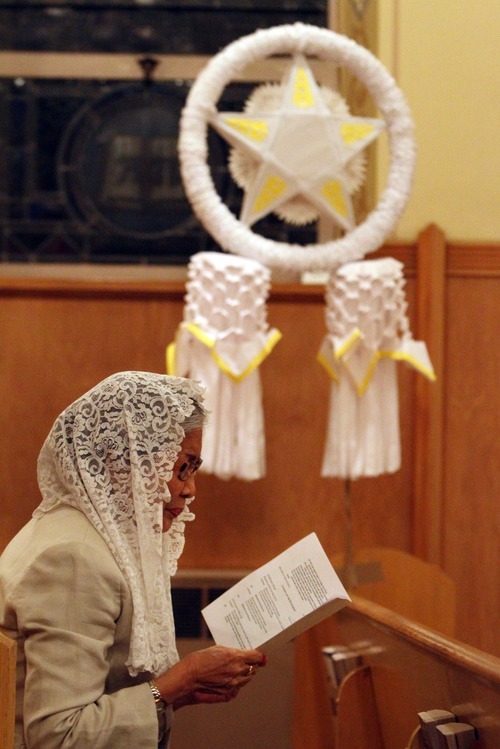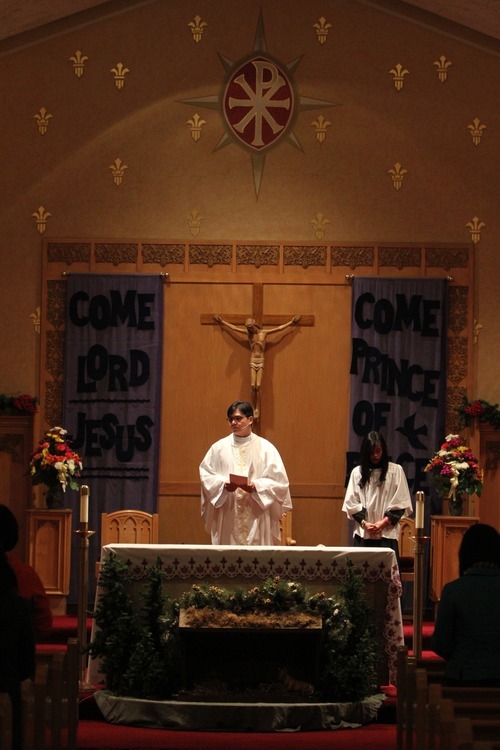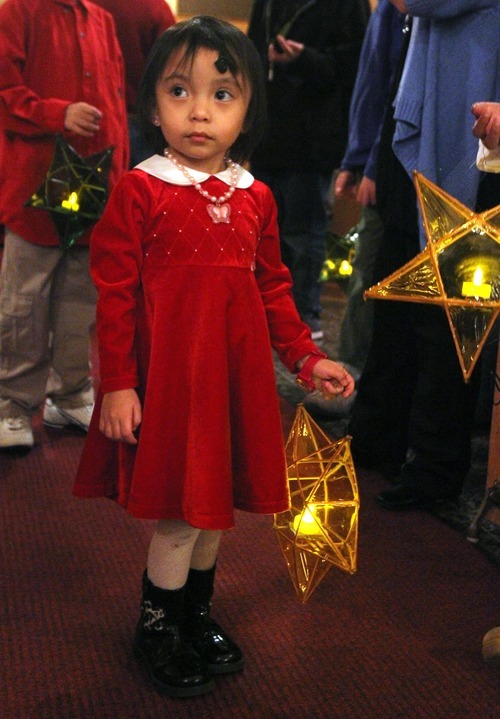This is an archived article that was published on sltrib.com in 2010, and information in the article may be outdated. It is provided only for personal research purposes and may not be reprinted.
Ten children — toddlers to teenagers — carried handmade cellophane lanterns shaped like stars into the darkened Our Lady of Lourdes Catholic Parish on Wednesday night, introducing a centuries-old Filipino tradition to Utah Catholics.
Nearly 50 natives of the Philippines and their families gathered at the church near the University of Utah for the inaugural Mass of Simbang Gabi, the Tagalog name for a nine-day novena of Masses leading up to Christmas.
In the Philippines, families are awakened by pealing church bells and roving bands of drummers and trumpeters, urging them to church for the 4 a.m. Simbang Gabi each of the nine mornings before Christmas.
Utah Filipinos figured that wouldn't work for their far-flung community in this cold climate, so they are celebrating in a different parish every night at 7:30 (save for one at 4:30 p.m.) through Dec. 23. Christmas Day Mass will be at 3:30 p.m. at Our Lady of Lourdes, followed by a Filipino potluck.
The Rev. Joseph Frez, a Filipino native, said in his homily on the first night that the novena is about more than nostalgia, importing traditions or making the Christmas celebration more festive.
"Our Simbang Gabi is a concretization of our waiting and expectation. Our Simbang Gabi is our expression of our hope for the coming of the Messiah," said Frez, whose ordination last spring helped invigorate the Catholic Filipino community, known as Misang Bayan.
An estimated 3,000 Utahns hail from the Philippines, and about 40 percent of them are Catholic, said Raul Yumul, one of the novena organizers.
The distinctly Filipino symbols, such as the parols (lanterns) and the "mano" blessing performed with the back of the hand are like other symbols in Catholic tradition, Frez said. "They point to a reality."
"Why do we need to concretize our hoping, our waiting and our expectation? ... Because we human beings are, by nature, beings of senses," Frez said. "That is also the whole point of the Incarnation. Jesus was made flesh so that we could see him, hear him, touch him and feel him ... so that God is not just an abstract idea but a reality and a person."
Much of this first Simbang Gabi novena will be about educating Filipinos who never learned or have forgotten the meaning of various traditions, said Yumul, who has been making parols from Japanese rice paper and bamboo for 23 years and oversaw the community's creation of parols earlier this month.
A written program available at each Mass has scriptural readings and hymn lyrics in English and Tagalog, an insert explaining a new custom each night, and a historical sketch of Simbang Gabi. It derives from a similar novena of Masses in Europe and was in use in the Philippines as early as the 17th century.
Masses were in the early morning because it was a time the farmers and fishers could worship together — the farmers before going to their fields and the fishers after long nights in their boats.
Older members of the community, such as Zenaida D. Torres, remember early risings for Simbang Gabi. "My grandmother would drag me to church," she said Wednesday night at a social that followed Mass.
Filipino members of Our Lady of Lourdes laid out a spread of traditional foods, including pansit (rice noodles cooked with vegetables), mami (broth with egg noodles and one's choice of green onions, chicken or hard-boiled egg) and puto (a rice cake the size of a small muffin).
Torres, one of the lectors during the Mass, wore a light-colored lace mantilla over her hair as she read from the Book of Isaiah in Tagalog.
Bringing Simbang Gabi to Utah, she said, "is a wonderful thing."
Frez himself conceded embarrassment that he didn't know the source of many of the customs, such as the parols.
"We took it for granted, but we didn't know the deeper meaning," said Frez, who came to Salt Lake City as a computer programmer in the mid-1990s. He later felt called to the priesthood, and, after six years in seminary, became a priest for the Salt Lake City Catholic Diocese last May.
He is the associate pastor at St. Francis Xavier Parish in Kearns.
Raul Yumul's wife, Edna, said the traditional Simbang Gabi is fading — even in the Philippines. "They are becoming Westernized," she said.
Raul Yumul maintains that, as Filipino-Americans celebrate and teach the traditions to their children, they will be the ones who restore those practices in the home country.
Filipino Catholics had long wanted to bring Simbang Gabi to Utah, but it was impossible without a priest who speaks Tagalog. The community occasionally pooled its money to fly in a Filipino priest at Christmas, but that was a one-day thing.
"Now that we have a new priest," Raul Yumul said, "we have no excuse." —
About Simbang Gabi
A novena is a form of worship comprising prayers or liturgy on nine straight days. The word "novena" comes from the Latin word for "nine." Filipino Catholics celebrate Simbang Gabi, a novena of Masses honoring the Virgin Mary.
This year's event kicked off at Our Lady of Lourdes Catholic Parish in Salt Lake City. The second and third nights were at St. Peter Parish in American Fork and St. Andrew Parish in Riverton, respectively. The community welcomes anyone interested to attend the remaining Simbang Gabi Masses. Get the schedule on B2.—
Mass schedule
Saturday, 7:30 p.m. • at St. Rose of Lima Parish, 210 S. Chapel St., Layton.
Sunday, 4:30 p.m. • at St. Thomas Aquinas Parish, 725 S. 250 East, Hyde Park.
Monday, 7:30 p.m. • at St. John the Baptist Parish, 300 E. 11800 South, Draper.
Tuesday, 7:30 p.m. • at St. Patrick Parish, 1040 W. 400 South, Salt Lake City.
Wednesday, 7:30 p.m. • at Sts. Peter and Paul Parish, 3580 W. 3650 South, West Valley City
Thursday, 7:30 p.m. • at Blessed Sacrament Parish, 1745 E. 9800 South, Sandy.
On Christmas Day • the Filipino community will gather for Mass and a dinner starting at 3:30 p.m. at Our Lady of Lourdes Parish, 1065 E. 700 South, Salt Lake City. —
Other yule services
For a list of other holiday worship services in area churches, go to C2.













